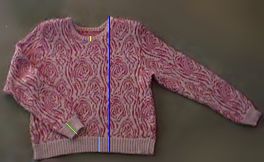Required Style Data for The Knitting Fiend.
- The Neck Welt.
- The Cuff Welt
- The Hem Welt.
- The Length of the sweater.
 Main
vs. Welt Stitches.
Main
vs. Welt Stitches.
Examine the picture to the right. You can see two stitch techniques are used.
Main Stitch.
The main stitch used in this sweater is the pink and pink swirly design.
It happens to be a fair isle stitch pattern. You can use any stitch
you like for the "main stitch".
Welt Stitch.
The welt is simply the trim used ribbing at the hem, cuffs and neck.
You can see the welts knit in light pink in the picture to the right.
Any non-curling stitch can be used to knit welts. These include all ribs, garter stitch, seed stitch, and double bed circular knitting on a knitting machine. For the sweater shown to the right, I knit my welts in 2 x 2 ribbing.
Definition: The word "welt" is just the general term for "trim" placed at the edge of knitting. Knitters often use ribbing, but sometimes they use garter stitch, seed stitch, or any stitch that doesn't curl.
